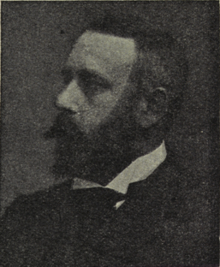Johannes Paulus Lotsy
Johannes Paulus Lotsy (April 11, 1867 – November 17, 1931) was a Dutch botanist, specializing in evolution and heredity. Lotsy was born in Dordrecht and died in Voorburg.
Johannes Paulus Lotsy | |
|---|---|
 Johannes Paulus Lotsy | |
| Born | April 11, 1867 |
| Died | November 17, 1931 (aged 64) |
| Nationality | Dutch |
| Known for | Works on evolution and heredity. |
| Spouse(s) | Catharina Christina Goossen |
| Scientific career | |
| Author abbrev. (botany) | Lotsy |
Career
After getting his PhD from Göttingen University he had a teaching positions at Johns Hopkins University (1891-1895) where he was director of the herbarium. From 1896 to 1900 he worked in Java. Then he taught at Leiden University (1904-1909), as a lecturer in Systematic Botany. He became director of the State Herbarium (Rijksherbarium) 1906–1909, then Secretary of the Hollandsche Maatschappij van Wetenschappen.
He founded the Association internationale des Botanistes and was editor of the Botanisches Centralblatt. He proposed a system of plant classification, based on phylogenetics. Lotsy argued for a major role of hybridization in evolution.[1][2]
Expeditions
India (1895-1900), the United States (1922), Australia and New Zealand (1925), South Africa (1926-27), and Egypt (1930). He also studied the flora of Italy and Switzerland.
Publications
- 1928. Voyages of exploration to judge of the bearing of hybridization upon evolution (Genetica : nederlandsch tijdschrift voor erfelijheids- en afstammingsleer). Ed. M. Nijhoff
- 1922a. Van den Atlantischen Oceaan naar de Stille Zuidzee
- 1922b. A popular account of evolution. The Cawthron institute, Nelson, Nueva Zelanda. Cawthron lecture. Ed. R.W. Stiles & Co. 22 pp.
- 1915. Het Tegenwoordige Standpunt der Evolutie-leer
- 1911. Série IIIA. Sciences exactes. 1–4. Rédigées par J. P. Lotsy
- 1906a. Résultats scientifiques du Congrès international de botanique, Vienne, 1905. Wissenschaftliche Ergebnisse des Internationalen botanischen Kongresses, Wien, 1905 ... Redigiert von J. P. Lotsy ... Mit ... 1 Karte, etc
- 1906b. Vorlesungen über Deszendenztheorien, mit besonderer Berücksichtigung der botanischen Seite der Frage, gehalten an der Reichsuniversität zu Leiden, etc.
- 1899. Rhopalocnemis Phalloides Jungh: A morphological-systematical study. Ed. E.J. Brill
- 1898. Contributions to the life-history of the genus Gnetum. Ed. E.J. Brill
- 1894. A contribution to the investigation of the assimilation of free atmospheric nitrogen by white and black mustard. Bulletin / U.S. Department of Agriculture, Office of Experiment Stations. G.P.O. 19 pp.
Books
- 2008. Evolution By Means Of Hybridization. Reeditado Maudsley Press. 176 pp. ISBN 978-1-4097-0261-0
- 1928. A Popular Account of Evolution
- 1925. Evolution considered in the light of Hybridization. Ed. Canterbury College by Andrews, Baty & Co. 66 pp.
- 1916. Evolution by Means of Hybridization. The Hague, Martinus Nijhoff, 166 pp.
- 1907–1911. Vorträge über botanische Stammesgeschichte gehalten an der Reichsuniversität zu Leiden. Ein Lehrbuch der Pflanzensystematik. In drei Bände. Jena, Verlag von Gustav Fischer. With illustrations.
- I. Algen und Pilze (Thallophyta) Jena: Gustav Fischer, 1907.
- II. Cormophyta Zoidogamia Jena: Gustav Fischer, 1909.
- III. Lotsy, J. P. (1911). Vorträge über botanische stammesgeschichte, gehalten an der Reichsuniversität zu Leiden. Ein lehrbuch der pflanzensystematick. III Cormophyta Siphonogamia (in German). Jena: G. Fischer.CS1 maint: ref=harv (link)
System
Lotsy argued that the monocotyledons were diphyletic, with the Spadiciflorae being derived from the dicotyledons (specifically Piperales) and the remainder from a hypothetical ancestor, the Proranales. Hutchinson, who argued for a monophyletic origin, considered this improbable.[3]
Synopsis
Vorträge über botanische Stammesgeschichte[4][3]
- Volume 3: Cormophyta Siphonogamia Part 1
- Monocotyledons vol 3(1) p. 514–564, 625–864
- Spadiciflorae p. 514–564
- Helobiae p. 625-692
- Enantioblastae p. 693-714
- Liliifloren p. 715–766, 792–834
- Liliaceae 714
- Melanthiaceae 717
- Asphodelaceae 722
- Aloinaceae 725
- Eriospermaceae 730
- Johnsoniaceae 731
- Agapanthaceae 732
- Alliaceae
- Gilliesiaceae 734
- Tulipaceae 735
- Scillaceae 741
- Asparagaceae 743
- Dracaenaceae 749
- Smilaceae 759
- Luzuriagaceae 760
- Ophiopogonaceae
- Lomandraceae 761
- Dasypogonaceae 763
- Calectasiaceae 764
- Juncaceae
- Flagellariaceae 765
- Stemonaceae (Roxburghiaceae) 792
- Cyanastraceae 793
- Iridaceae 794
- Crocoideae
- Iridoideae 796
- Ixioideae 799
- Haemodoraceae 800
- Amaryllidaceae 801, 811
- Hypoxidaceae
- Vellosiaceae 802
- Agavaceae 806
- Bromeliaceae 814
- Dioscoreaceae 823
- Taccaceae 826
- Burmanniaceen 829
- Glumifloren p. 767–791
- Scitamineae p. 835–864
- Index p. 952
- Monocotyledons vol 3(1) p. 514–564, 625–864
References
- East, E. M. (1914). A Theory of Evolution. Botanical Gazette 58 (1): 91-93.
- Newman, H. H. (1917). Evolution by Means of Hybridization by J. P. Lotsy. Botanical Gazette 63 (2): 153-154.
- Hutchinson 1959, pp. 513–515.
- Lotsy 1911.
- IPNI. Lotsy.
Bibliography
- Hutchinson, John (1959). The families of flowering plants, arranged according to a new system based on their probable phylogeny. 2 vols (2nd ed.). Macmillan.CS1 maint: ref=harv (link), Volume 2 at Internet Archive
- Works by or about Johannes Paulus Lotsy at Internet Archive
- Nature obituary
- National Herbarium Nederland: Lotsy, Johannes Paulus
External links
| Wikispecies has information related to Johannes Paulus Lotsy |
| Wikimedia Commons has media related to Johannes Paulus Lotsy. |
Note: This is a selected list of the more influential systems. There are many other systems, for instance a review of earlier systems, published by Lindley in his 1853 edition, and Dahlgren (1982). Examples include the works of Scopoli, Ventenat, Batsch and Grisebach.